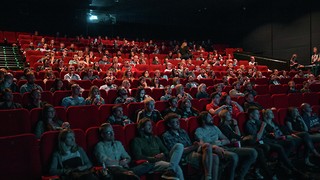Under Trinity: Under Milk Wood
An insight into an intriguing play

In New York, April, 1953 Dylan Thomas’ literary agent locked him in a room to complete the play script for Under Milk Wood. Final lines were handed to the actors minutes before they went onstage to debut the production. Speaking as an actor currently in Under Milk Wood, I can say that this would have been a truly terrifying experience. Contemporary critic Desmond Hawkins described Thomas’ style as a “sort of bomb that bursts” – and this would be an accurate metaphor for such a moment. It took me at least three intense sessions to learn a line such as: “come up the drifting sea dark street now in the dark night,” because word order and quantity of ‘darks’ are truly overwhelming for the logical side of the brain. To the untrained ear word-bomb debris litter what could be linear, sensical sentences. Thomas was a self-described drunk who would leave scripts behind in pubs, and at first the same organization patterns appear to occur amongst his words. As an actor you end up learning collections of sounds and images to remember his sentences.
If a sense of living in the moment is encapsulated in the event between Thomas and his literary agent, then in our director Jack Eastwood’s 2016 adaptation he too places actor and audience in an intimate, instant, dialogue. Playing with theatrical convention, the show sees audiences arrive to an underground cellar bar of Trinity College. Village inhabitants already walk around the space, and audiences are invited to view the production from any position in the room. Chairs are provided for those that need them, but otherwise individuals are invited to carve out their own home for the hour - and even move around the room after the show’s beginning.
Observers find themselves at the centre of a Welsh village where seagulls, ‘pink-eyed cottages’ and the ‘fishingboat-bobbing sea’ surround a smorgasbord of erotically charged yet excruciatingly repressed locals. The comfortable and uncomfortable sit together, much as the joy of Dylan finally completing his text before curtain up and the concern for actors actually remembering the lines must have done in 1953.
Jack Eastwood’s carefully designed blocking, with our ensemble of eight females, provides a steadfast framework that scaffolds the innovative piece. The production comes in a week in which the ADC also shows The Flick as its late show- where the audience sit on stage and actors perform in the audience. Coincidence, perhaps, that the two shows coincide – but their conception signals that immersive and subversive theatre are currently in vogue. In Cambridge, their programming challenges the norms of the proscenium arch format as it is generally communicated to us: we pay for tickets, we sit down, we watch actors on an end on stage, whilst the productions remain in dialogue with cultural trends currently pulsing through Britain and America.
For example, when Emma Rice, the creative force behind Cornwall’s Kneehigh Theatre, was appointed artistic director of The Globe in 2015 it signaled two landmarks in modern theatre history. She is not only the first female artistic director of Shakespeare’s world-renowned auditorium, but also the first to come from a background in immersive theatre. This year Kneehigh will also bring their Cornish brand to London’s Southbank – such recognition underlining the current buzz surrounding the genre. This follows other recent successes like Punch Drunk’s Drowned Man and The Barbican’s You Me Bum Bum Train where the individual audience member may, for example, find themselves thrust on to a sushi restaurant’s conveyor belt as a piece of sushi.
Eastwood’s Under Milk Wood however, is more subtle in immersing its audience. It was originally a radio ‘play for voices’, with audio so rich that overloading it would be like pouring extra glitter and sugar onto something already immensely sweet. This was a criticism made of Kevin Allen’s (2015), film adaptation of the text in a Guardian review. Starring Rhys Ifans and Charlotte Church this production contained gaudy bright colours, alongside multifarious camera angles - drawing on tropes from a Carry On movie.
Alfred Hickling argues that the real action of Under Milk Wood should be ‘within the language itself, which pulses and writhes with internal rhyme, alliteration and onomatopoeia.’ Eastwood does, like Allen, weave new visual languages into the work but these are far more minimalist- complementing rather than drowning Thomas’ original words. A black beanie hat, for example, distinguishes a man such as Mr Pugh, and a bonnet: a woman such as Polly Garter. Actors are clad otherwise in black.
Physical theatre dominates the piece and performers are at once puppets and puppeteers - playing subservient husbands whilst later transforming books into swooping birds. I struggle with the labeling of this text as a play – I keep calling it a piece. As an actor taking part, I think that’s what it is : a poem, project, or piece of art. Because if you come to Under Milk Wood expecting linear scenes with clear content, you will be disappointed. If you come looking for a new experience of, and format for, storytelling you could come away with thoughts more akin to Michael Sheen: “There is no other writer whose work can exhilarate me like his… No one whose vision of this life can fill me with the same sense of awe and appetite. No one whose words can make my mouth water as much, or whose images demand such mouthing.”
Under Milk Wood is on at The Wolfson Party Room, Trinity College, from the 22nd to the 25th of February, 2016 at 8pm. Tickets are £4 on the door.
 News / Tompkins Table 2025: Trinity widens gap on Christ’s19 August 2025
News / Tompkins Table 2025: Trinity widens gap on Christ’s19 August 2025 Comment / A plague on your new-build houses18 August 2025
Comment / A plague on your new-build houses18 August 2025 News / Pro-Palestine activists spray-paint Barclays Eagle Labs18 August 2025
News / Pro-Palestine activists spray-paint Barclays Eagle Labs18 August 2025 News / Pro-Palestine activists urge new Chancellor to ‘condemn Israel’20 August 2025
News / Pro-Palestine activists urge new Chancellor to ‘condemn Israel’20 August 2025 News / Trinity sells O2 Arena lease for £90m12 August 2025
News / Trinity sells O2 Arena lease for £90m12 August 2025









